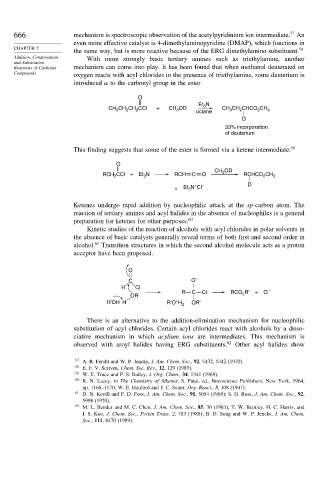Page 684 - Advanced Organic Chemistry Part A - Structure and Mechanisms, 5th ed (2007) - Carey _ Sundberg
P. 684
57
666 mechanism is spectroscopic observation of the acetylpyridinium ion intermediate. An
even more effective catalyst is 4-dimethylaminopyridine (DMAP), which functions in
CHAPTER 7 58
the same way, but is more reactive because of the ERG dimethylamino substituent.
Addition, Condensation With more strongly basic tertiary amines such as triethylamine, another
and Substitution
Reactions of Carbonyl mechanism can come into play. It has been found that when methanol deuterated on
Compounds
oxygen reacts with acyl chlorides in the presence of triethylamine, some deuterium is
introduced
to the carbonyl group in the ester.
O
Et N
3
CH CH CH CCl + CH OD octane CH CH CHCO CH 3
3
3
2
2
2
3
2
D
33% incorporation
of deuterium
This finding suggests that some of the ester is formed via a ketene intermediate. 59
O
CH OD
RCH CCl + Et N RCH C O 3 RCHCO CH 3
2
3
2
+
+ Et 3 N Cl – D
Ketenes undergo rapid addition by nucleophilic attack at the sp-carbon atom. The
reaction of tertiary amines and acyl halides in the absence of nucleophiles is a general
preparation for ketenes for other purposes. 60
Kinetic studies of the reaction of alcohols with acyl chlorides in polar solvents in
the absence of basic catalysts generally reveal terms of both first and second order in
alcohol. 61 Transition structures in which the second alcohol molecule acts as a proton
acceptor have been proposed.
O
C O –
R Cl
R C Cl RCO R' + Cl –
OR' 2
+
R'OH H R'O H 2 OR'
There is an alternative to the addition-elimination mechanism for nucleophilic
substitution of acyl chlorides. Certain acyl chlorides react with alcohols by a disso-
ciative mechanism in which acylium ions are intermediates. This mechanism is
observed with aroyl halides having ERG substituents. 62 Other acyl halides show
57 A. R. Fersht and W. P. Jencks, J. Am. Chem. Soc., 92, 5432, 5442 (1970).
58 E. F. V. Scriven, Chem. Soc. Rev., 12, 129 (1983).
59
W. E. Truce and P. S. Bailey, J. Org. Chem., 34, 1341 (1969).
60 R. N. Lacey, in The Chemistry of Alkenes, S. Patai, ed., Interscience Publishers, New York, 1964,
pp. 1168–1170; W. E. Hanford and J. C. Sauer, Org. React., 3, 108 (1947).
61 D. N. Kevill and F. D. Foss, J. Am. Chem. Soc., 91, 5054 (1969); S. D. Ross, J. Am. Chem. Soc., 92,
5998 (1970).
62
M. L. Bender and M. C. Chen, J. Am. Chem. Soc., 85, 30 (1963); T. W. Bentley, H. C. Harris, and
I. S. Koo, J. Chem. Soc., Perkin Trans. 2, 783 (1988); B. D. Song and W. P. Jencks, J. Am. Chem.
Soc., 111, 8470 (1989).

